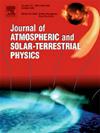Application of machine learning models for rainfall prediction and estimation of rain-induced attenuation for satellite communication in a tropical region
IF 1.8
4区 地球科学
Q3 GEOCHEMISTRY & GEOPHYSICS
Journal of Atmospheric and Solar-Terrestrial Physics
Pub Date : 2025-01-18
DOI:10.1016/j.jastp.2025.106443
引用次数: 0
Abstract
The increasing demand for advanced technological equipment and high-capacity data transfer with enhanced signal quality necessitates the transition to higher frequency bands, particularly those beyond the congested Ku and Ka bands (11–40 GHz). Higher frequency signals offer longer travel distances, increased information-carrying capacity, reduced interference, and high data rates, crucial for meeting the growing demand for wireless communication services. However, these frequencies are susceptible to rain-induced attenuation, particularly in tropical regions like Nigeria, where precipitation significantly degrades signal quality and impacts satellite communication services. This study analyzes 50 years of monthly rainfall data (1962–2011) obtained from the Nigerian Meteorological Agency (NiMet) for five Nigerian locations: Port Harcourt, Calabar, Enugu, Ibadan, and Ikeja. The data was divided into five decades using a decadal scaling technique to investigate the long-term trends of precipitation effects on radio wave propagation. The Coefficient of Variation (CV) and Chebil's model were employed to analyze rainfall variability and deduce 1-min rainfall rates, respectively. CV was found to be predominant during July and August across the decades, indicating significant worst months for signal qualities over the region. The seasonal variation of rainfall rates was also examined, showing significant effects.SARIMA, ARIMA, Random Forest and SVM forecasting models have been tested toward the prediction of rainfall in Nigeria. The SVM performed better than the other tested models with the highest adjusted R2 and least values of RMSE and MAE.The International Telecommunication Union's model (ITU-R P.618–14) was used to generate rain attenuation at Ku-band (12.275) GHz for the study locations. The findings confirm the reliability of Chebil's 1-min integration time rainfall rate model and validate decadal scaling as an effective method for developing mitigation measure for signal fading.
求助全文
约1分钟内获得全文
求助全文
来源期刊

Journal of Atmospheric and Solar-Terrestrial Physics
地学-地球化学与地球物理
CiteScore
4.10
自引率
5.30%
发文量
95
审稿时长
6 months
期刊介绍:
The Journal of Atmospheric and Solar-Terrestrial Physics (JASTP) is an international journal concerned with the inter-disciplinary science of the Earth''s atmospheric and space environment, especially the highly varied and highly variable physical phenomena that occur in this natural laboratory and the processes that couple them.
The journal covers the physical processes operating in the troposphere, stratosphere, mesosphere, thermosphere, ionosphere, magnetosphere, the Sun, interplanetary medium, and heliosphere. Phenomena occurring in other "spheres", solar influences on climate, and supporting laboratory measurements are also considered. The journal deals especially with the coupling between the different regions.
Solar flares, coronal mass ejections, and other energetic events on the Sun create interesting and important perturbations in the near-Earth space environment. The physics of such "space weather" is central to the Journal of Atmospheric and Solar-Terrestrial Physics and the journal welcomes papers that lead in the direction of a predictive understanding of the coupled system. Regarding the upper atmosphere, the subjects of aeronomy, geomagnetism and geoelectricity, auroral phenomena, radio wave propagation, and plasma instabilities, are examples within the broad field of solar-terrestrial physics which emphasise the energy exchange between the solar wind, the magnetospheric and ionospheric plasmas, and the neutral gas. In the lower atmosphere, topics covered range from mesoscale to global scale dynamics, to atmospheric electricity, lightning and its effects, and to anthropogenic changes.
 求助内容:
求助内容: 应助结果提醒方式:
应助结果提醒方式:


